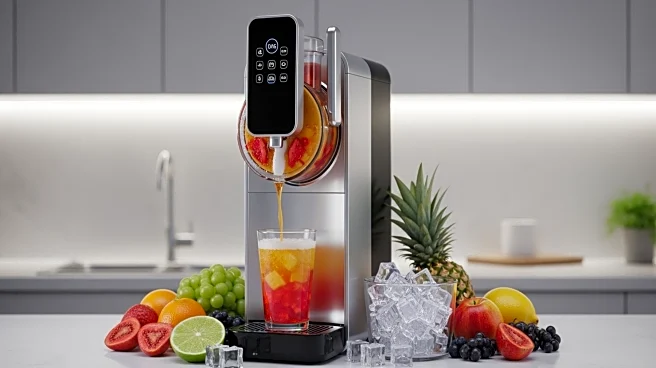What's Happening?
Ninja has introduced its latest kitchen appliance, the Ninja Slushi FS301UK, designed to create a variety of frozen drinks without the need for ice cubes or pre-freezing bowls. The machine can transform lemonade into icy slush, churn creamy frappes, and
produce frozen margaritas, all within minutes. Priced at approximately £349, the Slushi maker is a significant investment, taking up considerable counter space. The appliance features five presets for different drink types and ten freeze levels to customize drink consistency. The Slushi maker uses a refrigerated metal cylinder and an auger to freeze liquids directly, offering smoother results compared to traditional blenders.
Why It's Important?
The Ninja Slushi maker represents a shift in home appliance technology, focusing on convenience and quality in frozen drink preparation. This innovation could impact the beverage industry by encouraging more home-based preparation of specialty drinks, potentially reducing demand for store-bought options. Consumers seeking healthier alternatives to ice cream may find the Slushi maker appealing, although it requires a minimum sugar content for optimal operation. The appliance's versatility and ease of use may drive interest among families and entertainers, enhancing home dining experiences.
What's Next?
As the Ninja Slushi maker gains popularity, it may prompt competitors to develop similar products, potentially leading to advancements in home beverage technology. Consumer feedback will likely influence future iterations, focusing on reducing noise levels and enhancing functionality. The appliance's success could inspire Ninja to expand its product line, incorporating more features or developing complementary gadgets. Market trends will determine if the Slushi maker becomes a staple in home kitchens or remains a niche product.
Beyond the Headlines
The introduction of the Ninja Slushi maker highlights the growing consumer interest in specialized kitchen appliances that offer both fun and functionality. This trend reflects broader shifts in consumer behavior towards home-based culinary experiences and personalized food preparation. The appliance's reliance on sugar content raises questions about health implications, potentially sparking discussions on balancing convenience with nutritional value.













